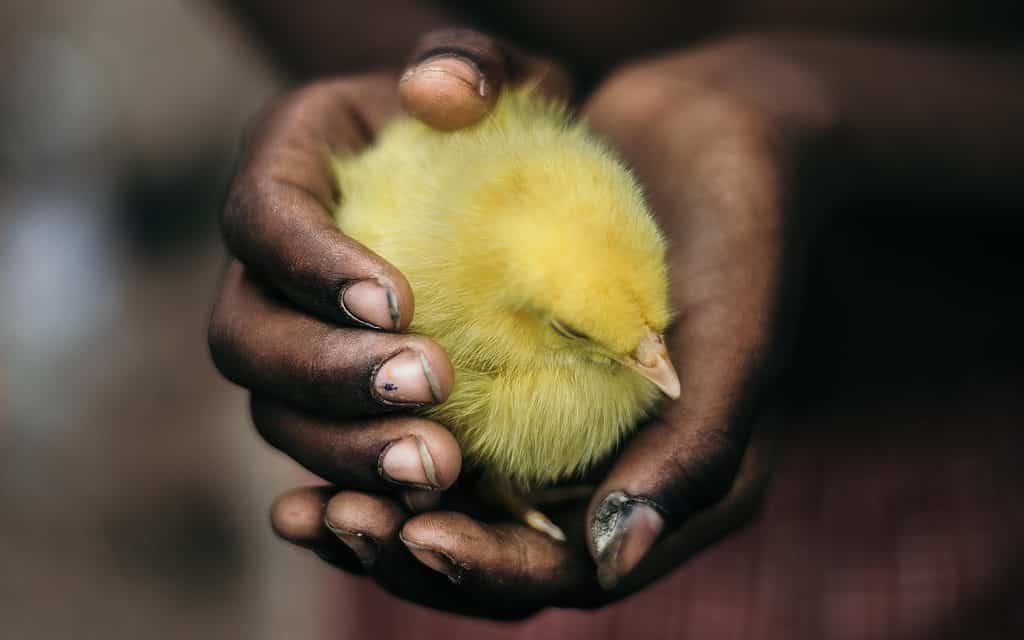
Chickens are by a wide margin the most numerous type of livestock on the planet, numbering over 23 billion. There are about 135 chickens for every cow and three for every human. But there probably would have been even more chickens in the world were it not for the widely established inhumane practice in the livestock industry of culling male chicks.
A gruesome industry
Male chicks have been dealt a bad hand. They don’t lay eggs and typically have less meat on their bones than hens, meaning they’re not only useless but a liability to farmers. As such, these undesirable byproducts of egg production may be killed through gassing, but oftentimes they are culled through maceration, which involves literally grinding up the male chicks alive. In the U.S., maceration is the standard practice.
But a groundbreaking development could have major implications for animal welfare in the poultry industry, perhaps finally putting an end to the culling of an estimated seven billion male chicks each year shortly after they hatch due to their lack of commercial value.
Israeli researchers at the Volcani Institute near Tel Aviv have created gene-edited hens that lay eggs from which only female chicks hatch. The team, led by Dr. Enbal Ben-Tal Cohen, used gene-editing tools to breed hens that produce eggs with unviable male embryos when exposed to blue light for several hours. Female chick embryos are unaffected by the light and continue to develop normally. The resulting chicks and eggs do not contain any additional genetic material, according to the team’s chief scientist, Dr. Yuval Cinnamon.
The ‘Golda hens’, as Cinnamon calls the gene-edited hens, could one day become the standard livestock reared in chicken farms, considering current trends in animal welfare. Germany and France jointly became the first countries in the world to prohibit all chick killing from 1 January 2022, and called on other EU member states to do the same, so these gene-edited hens can offer farmers an opportunity to selectively breed only hens while avoiding unnecessary mass killing.
“I am very happy that we have developed a system that I think can truly revolutionize the industry, first of all for the benefit of the chickens but also for all of us, because this is an issue that affects every person on the planet,” Dr. Cinnamon told the BBC.
Saving male chicks from the meat grinder with gene-editing tools
Here’s how it all works. Just like in humans, chicken sex determination hinges on the presence or absence of particular chromosomes. Chickens have a total of 78 chromosomes, arranged in 39 pairs, and the sex of the chicken is determined by the presence of two Z chromosomes in males or a Z and a W chromosome in females.
The Israeli scientists gene-edited the Z chromosome of the female chicken such that when it is combined with the Z chromosome from a rooster, the resulting male embryos are sensitive to blue light. The female chicks are unaffected and hatch normally, while the male chicks stop hatching altogether. The resulting chicks have no additional genetic material nor do the eggs they lay, so consumers will get exactly the same eggs they get today with no modification.
The team has not yet published its research, but it has worked in conjunction with the UK-based animal welfare organization Compassion in World Farming (CIWF) over the past three years. CIWF’s chief policy advisor, Peter Stephenson, called the development a “really important” step for animal welfare. “Normally I am very wary of using gene editing of farm animals. But this is an exceptional case and I, and my colleagues at CIWF, are supportive of it,” he said.
The next step for the team will be to ensure that the hen and its female chicks, who will lay eggs for human consumption, can go through a commercial lifespan without any unexpected welfare issues arising. The researchers plan to license the technology through their spin-off company, Huminn Poultry.
This is not the first time that gene-editing is being considered to stop chick culling. Researchers from the Australia’s Commonwealth Scientific and Industrial Research Organisation (CSIRO) have proposed using the gene-editing tool CRISPR to make male eggs fluorescent. By shining a laser on the egg, they can reveal the sex of a chicken on the same day it’s laid. The CRISPR technology would only affect the male chicks, and neither the layer hens nor the eggs sold for consumption would contain modified genes, which means consumers opposed to GMOs could accept such products if they are properly informed.
The potential benefits of the Golda hen go beyond animal welfare, as it could also reduce costs and improve efficiency for farmers and the industry as a whole. The mass culling of male chicks is not only tragic but also resource-intensive for farmers, who must manually sort males from females shortly after they hatch.






